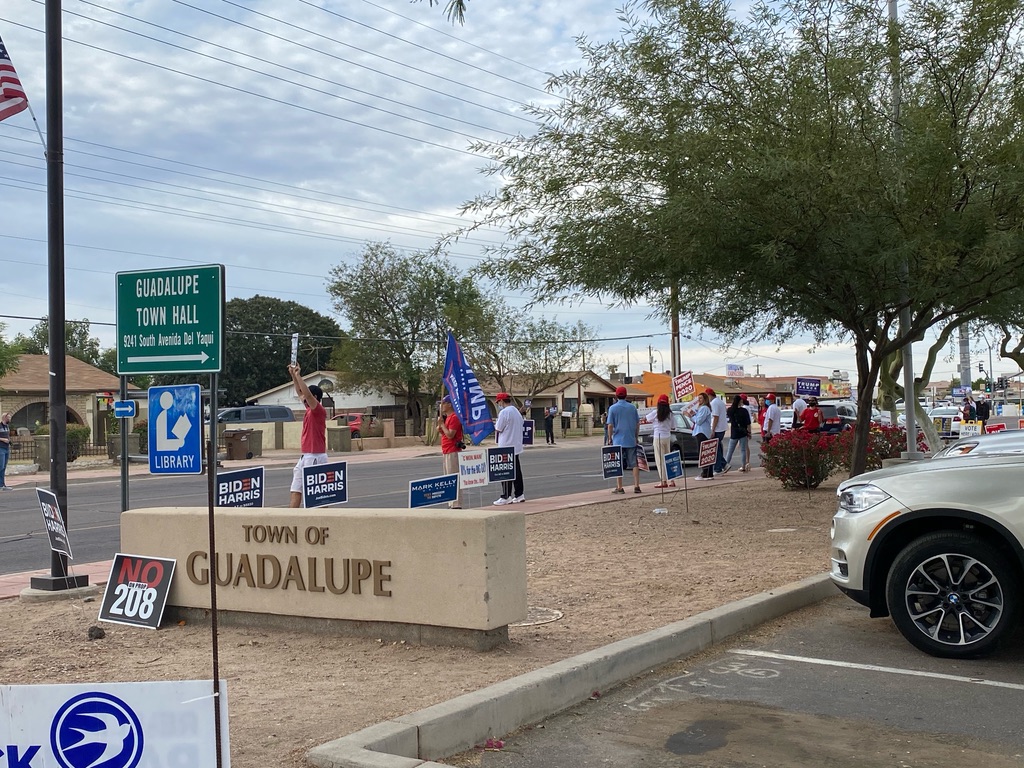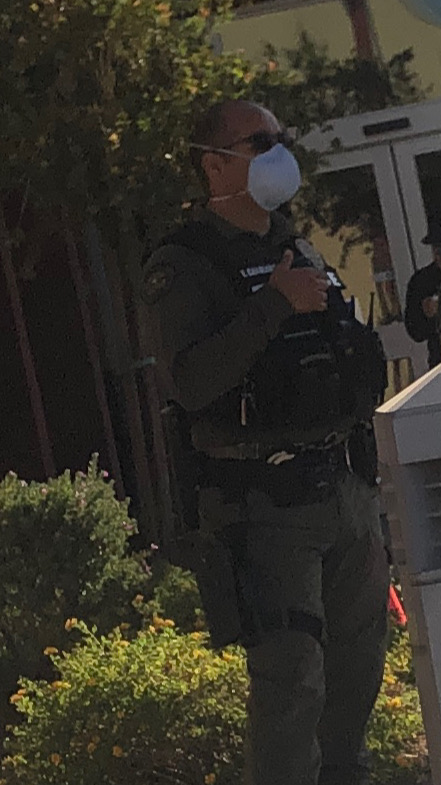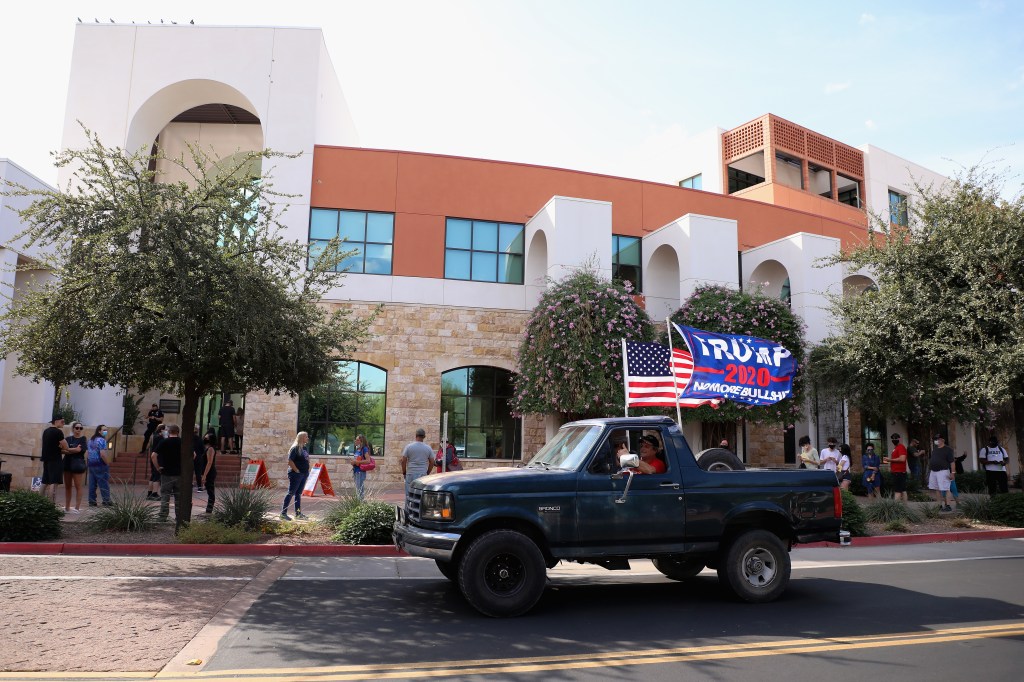Three days before the presidential election, a crowd of white Donald Trump supporters armed with MAGA flags and megaphones drove up in pickup trucks to a voting centre in Guadalupe, Arizona, where early voting was taking place. “Trump 2020,” they chanted, while handing out Republican flyers.
Moments later, people living in the area, primarily made up of Indigenous peoples including the Pascua Yacqui Tribe, and Latinx folks, drove by the rally, blaring rapper YG’s “FDT”—“Fuck Donald Trump.” Houses across the street decorated with Biden-Harris lawn signs also blasted music to drown out the Trump rally, said Brian Garcia, an Arizona Native Votes election-protection volunteer and enrolled member of Pascua Yaqui who witnessed the events.
Videos by VICE
Garcia said when he approached the rally, members said they were being paid to be there but didn’t specify by whom. “They said they’d have come for Biden if they got paid more,” he said.
It was voter intimidation, largely affecting Indigenous voters who didn’t enter the voting centre “steadily” until the chaos subsided, Garcia said.
The Republican Party of Arizona did not respond to VICE News requests for comment, but we will update the story if we hear back.
The rally was just one of the ways that Indigenous voters in Arizona were scared off or deterred from voting. In the lead-up to and on election day, they faced Democratic and Republican supporters trying to influence their votes, hostile poll workers, and unwanted police presence, Arizona Native Vote volunteers told VICE News. These tactics made voting hard in a state where election laws already make voting less accessible to Native Americans, they say.
Efforts to suppress the Native American vote shouldn’t come as a surprise: while Indigenous voters aren’t a monolith, they tend to vote Democrat and have managed to influence local, state, and federal elections, especially in swing states. In North Dakota, Indigenous peoples make up 5 percent of the population and were instrumental in former Democratic Senator Heidi Heitkamp’s narrow 2012 victory. Republicans cracked down on state election rules after Heitkamp’s win, making street addresses a requirement to vote, even though many tribal residents don’t have them.

In Arizona, Indigenous voters make up about 6 percent of the population and have influenced key races, including the 2018 election of Democratic Senator Kyrsten Sinema. After Sinema won, the Republican-led state legislature also introduced new voter eligibility requirements—a move that disproportionately affected Native Americans, sources told VICE News.
And they were pivotal in Joe Biden’s slim win in Arizona, called last week by the Associated Press. It’s only the second time in 70 years that the state has picked a Democratic presidential candidate.
As Navajo Times reported, voters in the three counties that cover Navajo Nation cast at least 73,954 ballots for Biden, compared to at least 2,010 for Trump—a 97 percent Biden turnout. (Statewide, Biden has won 49.4 percent of the vote, according to the Associated Press.)
High Country News reported the Indigenous vote also helped Biden clinch a narrow victory in Wisconsin.
It’s too early to tell if voter intimidation increased from previous elections. What is clear is that this was the first year where white people—both Republicans and Democrats—were electioneering on reservations, a particularly dangerous practice as Indigenous communities continue to grapple with COVID-19 outbreaks, said Patty Ferguson-Bohnee, a legal scholar and member of the Pointe-au-Chien tribe, who started the election protection project.
Ferguson-Bohnee warned against assuming Native American voter intimidation is something only Republicans do. “Voter suppression is not necessarily a Republican thing; it can be Democratic,” she said. “People have implicit and explicit biases against Native people and Native people in power.”
Torey Dolan, an enrolled member of Choctaw Nation, is in charge of Arizona Native Vote’s election hotline, a number for voters to call for support or to report intimidation. She said multiple polling centres in Apache County, which covers part of Navajo Nation and Fort Apache Indian Reservation, opened late, yet poll workers were reluctant to stay open longer to make up for it. Arizona Native Vote rushed to Arizona courts to force the polling sites to extend their hours, Dolan said.
Dorinda Bryan, a 39-year-old Navajo woman, showed up at her Saint Michaels polling site in Apache County at 6:55 p.m. on election day—five minutes before close, she told VICE News. According to Arizona election law, voters are eligible to cast their ballot if they’re in line before polls close. But Bryan said after waiting more than an hour and a half, the door was effectively “slammed in her face” and she was denied her right to vote.
“I’m just upset. It’s just not right,” Bryan said. “We did have Indigenous people running at the state level as well and I wanted to vote and be part of history.”
According to Bryan, at least 15 Navajo voters were denied their right to cast their ballots.

Apache county attorney Michael Whiting, one of the officials who oversaw the election, said he was unaware that people were turned away at Saint Michaels, but called the reports “disheartening.”
“That should not happen; if a voter is on the premises you let them vote,” Whiting said. “I guarantee at least 10 of the 15 drove down dirt roads and it took them significant time and money to get to that polling location.”
Whiting also confirmed three sites opened late and a court order forced them to remain open late. “We think the judge made the right decision to keep them open,” Whiting told VICE News.
In Pima and Yuma counties, armed police dressed in tactical gear showed up to monitor voting sites, making Native American voters uncomfortable, Dolan said. A Yuma County spokesperson said police were brought in to support poll workers after there were reports of people nearby blasting partisan radio. The Pima County recorder did not respond to multiple VICE News requests for comment.
Dolan said Pima County kept law enforcement on site even after Native Vote and a local mayor asked for them to be removed.
“Not every person has a great relationship with police, particularly communities of color,” Dolan said. “When you have them at the polling location…that might be intimidating. They may be physically armed and have an imposing presence.”
Ferguson-Bohnee said she watched as an Indigenous elder walked out of an early voting site bewildered. “He was so rattled. I asked how his experience was and he said it was so hostile,” Ferguson-Bohnee said.
The poll worker, who was white, made the elder remove his face mask and refused to acknowledge that the man looked like his ID picture. After the elder cast his ballot, the same poll worker allegedly said, “I’m going to call you later to see if you voted the right way,” Ferguson-Bohnee said.
There were also multiple reports of poll workers misleading Native American voters, even if unintentionally, by wrongly handing out provisional ballots and failing to help people pinpoint correct precincts, Arizona Native Vote volunteers said.
Arizona’s Secretary of State did not respond to voter intimidation allegations.
VICE News previously reported how difficult it can be for people living in tribal communities to vote, whether in person or by mail; long distances between peoples’ homes and polling sites or mailboxes mean casting a ballot takes a lot of time, resources, and will. Indigenous peoples often don’t have access to broadband or Wi-Fi, which makes finding election information challenging as well.
Arizona’s election laws also disenfranchise Indigenous voters, Ferguson-Bohnee said. Mail-in ballots, which are most accessible for people in urban centres, only require voters to sign ballot applications, and later use the same signature on ballots for verification. To vote in person, people need ID cards with valid addresses, even though many people in tribal communities don’t have street addresses, she said.
And yet, thousands of Native Americans voters were undeterred and ultimately helped Arizona lock in a historic win for the Democrats—and Indigenous grassroots election advocacy is partly to thank.
Manuel Fulton, a Navajo organizer with Four Directions, an Indigenous voter advocacy group, always works hard to get Indigenous voters registered and to the polls. He even led a COVID-19-safe campaign that drove Navajo residents to polling precincts by appointment.
“Voting allows for peoples’ dreams to come true,” Fulton said. “Big ‘ol hats off for people who threw in their votes even though there were long lines.”
The 52-year-old said he does the work for the youth and elders, like the 95-year-old Navajo grandmother who he visited earlier this year. The woman was 40 when she voted for the first time by hitchhiking to the polling centre. She hasn’t missed an election since, and she prays to Navajo’s four sacred mountains during every one, Fulton said.
“She told me, ‘It’s because of my kids. I love my kids.’”
Follow Anya Zoledziowski on Twitter.




